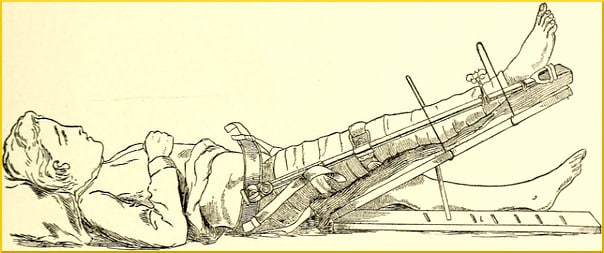
Blount’s disease, or Blount disease, or tibia varia, used to be called bowleg deformity, and it results from pressure on the growth plate at the tibia’s proximal end. What would exert abnormal force on a medial tibial growth plate? There is pretty good evidence that the answer is, obesity.
Journalist Hank Black explains,
Blount disease occurs in early-onset and late-onset forms… The disease is characterized by progressive multi-planal deformities […] along with limb shortening. The result can be gait deviations and limb-length discrepancy, which may contribute to premature knee osteoarthritis.
Very rarely, a milder early-onset case will clear up on its own. Leg braces may have helped some kids, and up until recently, stapling and surgery (on children as young as four) were the corrective methods of choice. But, if the desired results are greater patient activity and/or reduced BMI, surgical intervention has turned out to be pretty much futile.
Just to confirm that, a research team conducted a retrospective study. Black reported,
[Dr. Sanjeev] Sabharwal and colleagues found a significant relationship between BMI and severity of radiographic deformities in children with early-onset Blount disease, but not in those with late-onset disease.
Dr. Sabharwal said,
Many parents and physicians see excess weight as a product of immobility due to limb deformity and believe if the limbs were aligned properly, the child’s activity level would increase and obesity would resolve.
Sadly, that has not often turned out to be the case. Even with “six to eight weeks of inpatient rehabilitation that included dietary control and nutritional counseling,” the surgery kids did not lose weight. On the contrary, 76% achieved even higher BMI scores than before. Black wrote,
At follow-up, the average BMI of the cohort had increased from 35 preoperatively to 38, and the number of morbidly obese children had increased from 12 to 20.
One very big stumbling block is that medical teams can only influence nutritional standards and calorie intake when patients are recovering in the hospital. Once they go home, all bets are off. Blame, according to Dr. Sabharwal, should not be allotted, because people could be economically deprived and cannot afford the healthful habits that a family should follow.
The best a doctor can do, under the circumstances, is to address the patient and family, well before knee or hip surgery takes place, and warn everyone not to expect any subsequent slimming. The surgical realignment of bones does not promote weight-loss — although weight-loss surgery might — the bariatric kind, that is.
Speaking of surgery…
Suppose a teenager needs an operation to fix an obesity-related orthopedic problem? This could be difficult, because while the patient is under anesthesia, his enormous stomach engulfs his torso, exerting pressure like a beanbag chair filled with a hundred pounds of actual beans. The compression interferes with vital processes like introducing oxygen into the unconscious frame.
At the urging of heart surgeon Mehdi Razavi, Rice University students came up with an invention, described here by journalist Brian Alexander, capable of relieving that hazardous pressure:
The device the students designed uses suction cups hooked to a horizontal beam hovering above the abdomen. The cups are attached to the skin — there is a slight chance of bruising, student Marisa Prevost said — and a vacuum pump. Activating the device slightly raises the abdomen so the fat is out of the way.
Is that cool, or what?
Your responses and feedback are welcome!
Source: “BMI does not drop after surgical realignment for Blount disease,” LerMagazine.com, August 2014
Source: “Too fat for anesthesia? Suction cups hold up patients’ guts during surgery,” NBCNews.com, 05/10/12
Photo credit: Internet Archive Book Images on Visualhunt/No known copyright restrictions

 FAQs and Media Requests:
FAQs and Media Requests: 











